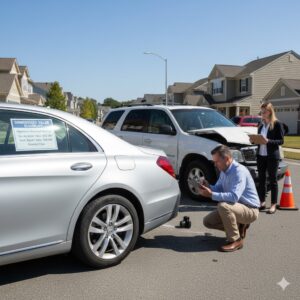Call us now:
Diminished value is the loss in your vehicle’s market worth after it’s been repaired from an accident even when the repairs are done correctly.
Understanding Diminished Value
If your car has been in an accident, chances are it’s worth less than it was before even after professional repairs. This drop in resale or trade in value is called diminished value. Buyers and dealerships often pay less for vehicles that have been in accidents because the car’s history report shows prior damage. Even when repairs are done perfectly, the stigma of “previous accident” remains and that’s what creates the financial loss.
Quick Tip: Who Can File a Diminished Value Claim in Florida
In Florida, only the claimant meaning the person filing a third-party claim against the at-fault driver’s insurance can pursue diminished value. If you’re filing through your own insurance policy (a first-party claim), most policies do not cover diminished value unless explicitly stated.
Read more here: Who Qualifies for a Diminished Value Claim
How Appraisers Calculate Diminished Value
When Auto Praise performs a diminished value appraisal, we look beyond generic formulas or automated software used by insurance companies. Our process involves a detailed analysis of the specific factors that affect a vehicle’s post-repair value in the real-world resale market.
Key factors a certified appraiser reviews:
• Pre-accident condition and maintenance history
• Age and mileage at the time of loss
• Vehicle history reports (Carfax, AutoCheck) showing prior damage or title issues
• Vehicle class and market segment (luxury, exotic, standard)
• Extent and location of repairs, including any structural damage
• Used car market and actual trade in offers
Why the 17c Formula Shouldn’t Be Used to Calculate Diminished Value
Most insurance companies use what’s known as the 17c formula to calculate diminished value. This method uses arbitrary caps and multipliers that almost always result in lower payout offers and does not reflect true resale or trade-in market values.
| Approach | Used By | Methodology | Accuracy | Market Reflection |
| 17c Formula | Insurance companies | Basic math formula with arbitrary caps | Low | Doesn’t reflect actual resale/trade-in values |
| Professional DV Appraisal | Independent firms (Auto Praise) | Condition, mileage, repair severity, verified comps | High | Reflects true buyer perception & market loss |
Real World Example: High End Luxury Vehicle with Structural Damage
Auto Praise was hired to perform a diminished value appraisal for a 2023 Mercedes Benz S Class that sustained structural damage in a collision. The vehicle was only two months old with 1,500 miles at the time of the accident. Although it was repaired to pre-loss cosmetic condition, the structural damage caused a major decrease in market desirability. The insurer’s 17c calculation suggested a loss of under $5,000. Our USPAP compliant appraisal report found the actual diminished value exceeded $20,000.
Need a Diminished Value Appraisal
Auto Praise provides USPAP compliant diminished value appraisals that reflect real market conditions
and support fair claim outcomes. Our certified team evaluates condition mileage repair severity and verified market data
so your claim is based on accurate evidence not generic formulas.
Learn more about Diminished Value Appraisals
From My Experience
Over the years, I’ve reviewed hundreds of diminished value reports from insurance companies and many undervalue vehicles by thousands of dollars. The 17c formula simply doesn’t align with what buyers are willing to pay in the real world. My job as an independent appraiser is to make sure clients receive a valuation that reflects the financial loss that the vehicle owner will experience when trading the car in or selling it privately, not what a formula suggests.
Key Takeaways
• Diminished value represents the real world loss in resale or trade in value after repairs.
• Only third party claimants in Florida can pursue diminished value.
• Insurance carriers often use the flawed 17c formula, which minimizes payouts.
• Professional appraisals provide accurate, market-based valuations.
• Vehicles with structural damage or newer models typically suffer the greatest loss.
Recommended Resources
• Florida Department of Financial Services – Consumer Resources: https://www.myfloridacfo.com/Division/Consumers
• National Association of Insurance Commissioners (NAIC) – Auto Claims Help: https://content.naic.org/consumer.htm
• Kelley Blue Book – Car Value Tools: https://www.kbb.com/
FAQs
If your car was damaged by another driver, repaired, and has no prior accidents on record, you may qualify.
In most cases, no. Florida allows only third-party claims unless your policy explicitly includes DV coverage.
It uses arbitrary caps and ignores real market factors like vehicle class, repair severity, and local comps.
Luxury, high-performance, and late-model vehicles typically experience the greatest loss.


